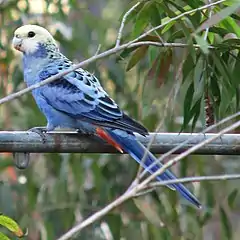| Platycercini | |||
| Selby, 1836[1] | |||
 Przedstawiciel plemienia – rozella blada (Platycercus adscitus) | |||
| Systematyka | |||
| Domena | |||
|---|---|---|---|
| Królestwo | |||
| Typ | |||
| Podtyp | |||
| Gromada | |||
| Podgromada | |||
| Infragromada | |||
| Rząd | |||
| Rodzina | |||
| Podrodzina | |||
| Plemię |
Platycercini | ||
| Typ nomenklatoryczny | |||
|
Platycercus Vigors, 1825 | |||
| Rodzaje | |||
| |||
Platycercini – plemię ptaków z podrodziny dam (Loriinae) w obrębie rodziny papug wschodnich (Psittaculidae).
Zasięg występowania
Plemię obejmuje gatunki występujące w Australazji i na Fidżi[2].
Systematyka
Do plemienia należą następujące rodzaje[3]:
- Psephotus Gould, 1845 – jedynym przedstawicielem jest Psephotus haematonotus (Gould, 1838) – świergotka seledynowa
- Northiella Mathews, 1912
- Purpureicephalus Bonaparte, 1854 – jedynym przedstawicielem jest Purpureicephalus spurius (Kuhl, 1820) – pąsogłówka
- Psephotellus Mathews, 1913
- Barnardius Bonaparte, 1854 – jedynym przedstawicielem jest Barnardius zonarius (Shaw, 1805) – rozella czarnogłowa
- Platycercus Vigors, 1825
- Lathamus Lesson, 1830 – jedynym przedstawicielem jest Lathamus discolor (Shaw, 1790) – papużka ostrosterna
- Prosopeia Bonaparte, 1854
- Eunymphicus J.L. Peters, 1937
- Cyanoramphus Bonaparte, 1854
- Pezoporus Illiger, 1811
- Neopsephotus Mathews, 1912 – jedynym przedstawicielem jest Neopsephotus bourkii (Gould, 1841) – łąkówka liliowa
- Neophema Salvadori, 1891
Przypisy
- ↑ P.J. Selby: Natural history of parrots. Edinburgh: W. H. Lizars, 186, s. 57, seria: The naturalist’s library. Ornithology. (ang.).
- ↑ S.M. Billerman, Old World Parrots (Psittaculidae), version 1.0, [w:] S.M. Billerman, B.K. Keeney, P.G. Rodewald & T.S. Schulenberg (red.), Birds of the World, Cornell Lab of Ornithology, Ithaca, NY 2020, DOI: 10.2173/bow.psitta4.01 [dostęp 2020-10-22] (ang.).

- ↑ Systematyka i nazwy polskie za: P. Mielczarek, M. Kuziemko: Plemię: Platycercini Selby, 1836 (Wersja: 2023-12-29). [w:] Kompletna lista ptaków świata [on-line]. Instytut Nauk o Środowisku Uniwersytetu Jagiellońskiego. [dostęp 2024-02-15].
This article is issued from Wikipedia. The text is licensed under Creative Commons - Attribution - Sharealike. Additional terms may apply for the media files.